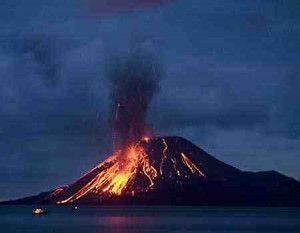Toba
Krakatoa
Krakatoa, the Indonesian volcano that erupted so violently in 1883, produced many recorded effects that are frequently used as yardsticks when discussing the possible consequences of similar events in the past, particularly the second millennium BC destruction of Thera, a leading contender in the Atlantis stakes.  The Krakatoan eruption had a detrimental effect on global climates for some years.
The Krakatoan eruption had a detrimental effect on global climates for some years.
However, this was not the first time that the eruption of Krakatoa had calamitous global consequences. David Keys (image below), an archaeological journalist, details the effects of an eruption of Krakatoa in 534/5 AD, in his book, Catastrophe[1330]. This book was the subject of a documentary on the UK’s Channel Four(d). A few years before his book was published Keys wrote an article entitled: Comet may have caused catastrophe on Earth(e), in which he dismissed a volcanic eruption as the cause of the 6th century crop failures, plagues, wars, social unrest and widespread deaths, yet his subsequent book advocates[p.269] a massive eruption of Krakatoa as the culprit. Around the same time, Mike Baillie was about to publish his Exodus to Arthur [0111] in which he argued
strongly that the mid-6th century range of catastrophes were caused by a cometary impact. Five years later, Baillie co-authored, with Patrick McCafferty, another book linking comets with Irish mythology, The Celtic Gods, in which they point out that Keys’ proposed huge eruption has not been reflected in any of the various Greenland ice cores in the form of a volcanic-acid spike[0112.164]!
This debate regarding the cause of the global catastrophes in the mid-6th century would appear to be far from over. A 2015 report(f) suggests that a series of North American volcanic eruptions in 536 AD had such a detrimental effect on the climate of Europe that it contributed to the final demise of the Roman Empire. Furthermore, there is now evidence(g) that the eruption of the El Chicon volcano in Southern Mexico around 540 AD led to the disruption of the Maya civilisation. Matthew Toohey from the GEOMAR Helmholtz Centre for Ocean Research in Kiel, Germany, has suggested the possibility of a double event!
Early in the 19thcentury the eruption of Tambora, also in Indonesia, was even more powerful(a). However, the most violent eruption of the last two million years also took place in Indonesia 74,000 years ago, when Mt. Toba erupted with devastating consequences for the Indian sub-continent and further afield(b). The Toba caldera is now Lake Toba.
>The devastation caused by the Toba eruption led some, such George Weber and the author of Supervolcano [2085], John Savino, to propose that the event created a genetic evolutionary bottleneck. Although a number of articles(c) in recent years have supported the ‘bottleneck’ theory that led to the near extinction of humans, the idea has been strongly opposed in other quarters(h).<
The Theran eruption was equivalent to the 19th century Krakatoa event when measured according to a volcanic explosivity index (VEI), based on quantitative criteria, as discussed in Walter Friedrich’s book on Thera[428]. Within a decade, the explosivity figure for Thera was reassessed by Professor Floyd McCoy of the University of Hawaii, who has written and broadcast extensively on the matter of the Late Bonze Age eruption of Thera. This included a paper delivered to the 2005 Atlantis Conference. In it, he noted that “New finds of tephra – ash and pumice – both on land and on the seafloor indicate a far larger eruption than previously assumed, suggesting a volume of at least 100 km3 of tephra (bulk volume) ejected, perhaps more. Such a volume ranks the eruption on the Volcanic Explosivity Index (VEI) at 7.0, equivalent or larger than the 1815 eruption of Tambora (‘the year without a summer’), ten times larger than the eruption of Krakatau in 1883, and approximately 100 times that of Mt. St. Helens in 1980.” [629.311]
When we watched the 20th century eruption of Mt. St. Helens or the Montserrat volcanoes on our televisions, it gave no real notion of the incredible power of these events or the absolute terror that was experienced by those living close by.
(a) https://www.volcanodiscovery.com/tambora.html
(b) https://creativesystemsthinking.wordpress.com/2014/10/24/did-humans-almost-die-out-70000-years-ago/
(d) https://www.davidkeys.co.uk/davids-documentaries/ (Link broken Nov. 2018)
(f) https://www.bbc.com/news/science-environment-36086096
(g) https://www.unexplained-mysteries.com/news/283466/volcanoes-hastened-fall-of-the-roman-empire

